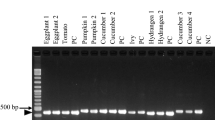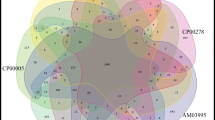Abstract
Unique DNA bands from strains representative of two groups of Pseudomonas corrugata, as shown by amplification of their genomic DNA by polymerase chain reaction using short random sequence oligonucleotide primers (RAPD-PCR), were isolated, cloned and sequenced. Two pairs of specific primer sequences, based on the ends of the cloned unique DNA bands from strains IPVCT10.3 and IPVCT8.1, were used in multiplex PCR with a range of P. corrugata strains. All strains produced one of the two specific bands, 1100 bp (from the IPVCT10.3-based primers) and 600 bp (from the IPVCT8.1-based primers), representing groups designated I and II, respectively. The primers were also tested on a wider range of Pseudomonas species, including the closely-related fluorescent Pseudomonas genomospecies FP1, FP2 and FP3: none of these bacteria produced any bands following amplification by PCR with these primers. The primer sets detected P. corrugata in tomato pith necrosis-infected plants providing a useful tool for rapid identification and epidemiological studies.
Similar content being viewed by others
References
Alivizatos AS (1984) Aetiology of tomato pith necrosis in Greece. In: Proceedings of the 2nd Working Group Pseudomonas syringae Pathovars, Athens, Greece, Hellenic Phytopathological Society, pp. 55–57
Alivizatos AS (1985) Bacterial wilt of tomato in Greece caused by Erwinia chrysanthemi. Plant Pathol 34: 638–639
Arnold DL, Athey-Pollard A, Gibbon, MJ, Taylor JD and Vivian A (1996) Specific oligonucleotide primers for the identification of Pseudomonas syringae pv. pisi yield one of two possible fragments by PCR amplification: evidence for phylogenetic divergence. Physiol Mol Plant Pathol 49: 233–245
Audy P, Laroche A, Saindon G, Huang HC and Gilbertson RL (1994) Detection of the bean common blight bacteria, Xanthomonas campestris pv. phaseoli and X. c. phaseoli var. fuscans. Phytopathology 84: 1185–1192
Audy P, Braat CE, Saindon, G, Huang HC and Laroche A (1996) Arapid and sensitive PCR-based assay for concurrent detection of bacteria causing common and halo blights in bean seed. Phytopathology 86: 361–366
Bradbury JF (1987) Pseudomonas corrugata. In: CMI Description of Pathogenic Fungi and Bacteria, No. 893. Commonwealth Mycological Institute, CAB International, Ferry Lane, Surrey, England
Catara V and Albanese G (1993) La 'Necrosi del midollo' del pomodoro in Sicilia. Inf Fitopatol 43: 42–44
Catara V, Gardan L and Lopez MM (1997) Phenotypic heterogeneity of Pseudomonas corrugata strains from southern Italy. J Appl Microbiol 83: 576–586
De Vos P, Goor M, Gillis M and De Ley J (1985) Ribosomal ribonucleic acid cistron similarities of phytopathogenic Pseudomonas species. Int J Syst Bacteriol 35: 169–184
Dhanvantari BN (1990) Stem necrosis of greenhouse tomato caused by a novel Pseudomonas sp. Plant Dis 74: 124–127
Dhanvantari BN and Duks VA (1987) Bacterial stem rot of greenhouse tomato: etiology, spatial distribution, and effect of high humidity. Phytopathology 77: 1457–1463
Fiori M (1992) A newbacterial disease of Chrysanthemum: a stem rot by Pseudomonas corrugata Roberts et Scarlett. Phytopathol Medit 31: 110–114
Henson JM and French R (1993) The polymerase chain reaction and plant disease diagnosis. Annu Rev Phytopathol 31: 81–109
King EO, Ward MK and Raney DE (1954) Two simple media for the demonstration of pyocyanin and fluorescein. J Lab Clin Med 44: 301–307
Lopez MM, Rodriguez FR, Montojo AM, Salcedo RJ and Marti RJ (1988) Pepper, a newhost of Pseudomonas corrugata. In: 5th International Congress of Plant Pathology, Kioto, Japan, ISPP 98. Abstracts book, p. 98
Lopez MM, Siverio F, Albiach R, Garcia F and Rodriguez FR (1994) Characterization of Spanish isolates of Pseudomonas corrugata from tomato and pepper. Plant Pathol 43: 80–90
Magyarosy AC and Buchanan BB (1995) First report of Pseudomonas corrugata causing pith necrosis on geraniums. Phytopathology 85: 1040
Manulis S, Valinsky L, Lichter A and Gabriel DW (1994) Sensitive and specific detection of Xanthomonas campestris pv. pelargonii with DNA primers and probes identified by random amplified polymorphic DNA analysis. Appl Environ Microbiol 60: 4094–4099
Pooler MR, Ritchie DF and Hartung JS (1996) Genetic relationships among strains of Xanthomonas fragariae based on random amplified polymorphic DNA PCR, repetitive extragenic palindromic PCR, and enterobacterial repetitive intergenic consensus PCR data and generation of multiplexed PCR primers useful for the identification of this phytopathogen. Appl Environ Microbiol 62: 3121–3127
Sambrook J, Fritsch EF and Maniatis TA (1989) Molecular Cloning: A Laboratory Manual. 2nd edn. Cold Spring Harbor Laboratory, Cold Spring Harbor, NY
Scarlett CM, Fletcher JT, Roberts P and Lelliott RA (1978) Tomato pith necrosis caused by Pseudomonas corrugata n. sp. Ann Appl Biol 88: 105–114
Siverio F, Cambra M, Gorris MT, Corzo J and Lopez MM (1993) Lipopolysaccharides as determinants of serological variability in Pseudomonas corrugata. Appl Environ Microbiol 59: 1805–1812
Siverio F, Carbonell EA, Garcia F and Lopez MM (1996) Characteristics of the whole cell fatty acid profiles of Pseudomonas corrugata. Eur J Plant Pathol 102: 519–526
Skoudridakis M (1986) Problemes des maladies bacteriennes en cultures maraicheres protegees en Crete. EPPO Bull 16: 437–439
Stead DE (1992) Grouping of plant-pathogenic and some other Pseudomonas spp. by using cellular fatty acid profiles. Int J Syst Bacteriol 42: 281–295
Sutra L, Siverio F, Lopez MM, Hunault G, Bollet C and Gardan L (1997) Taxonomy of Pseudomonas strains isolated from tomato pith necrosis: emended description of Pseudomonas corrugata and proposal of three unnamed fluorescent Pseudomonas genomospecies. Int J Syst Bacteriol 47: 1020–1033
Victoria JI and Granada GA (1983) Abacterial soft rot of tomatoes induced by Erwinia chrysanthemi in Cauca Valley (Columbia). Fitopatologia 18: 31–33
Wilkie J and Dye DW (1974) Pseudomonas cichorii causing tomato and celery diseases in New Zealand. New Zealand Journal of Agricultural Research 17: 123–130
Author information
Authors and Affiliations
Rights and permissions
About this article
Cite this article
Catara, V., Arnold, D., Cirvilleri, G. et al. Specific Oligonucleotide Primers for the Rapid Identification and Detection of the Agent of Tomato Pith Necrosis, Pseudomonas corrugata, by PCR Amplification: Evidence for two Distinct Genomic Groups. European Journal of Plant Pathology 106, 753–762 (2000). https://doi.org/10.1023/A:1026507423848
Issue Date:
DOI: https://doi.org/10.1023/A:1026507423848




